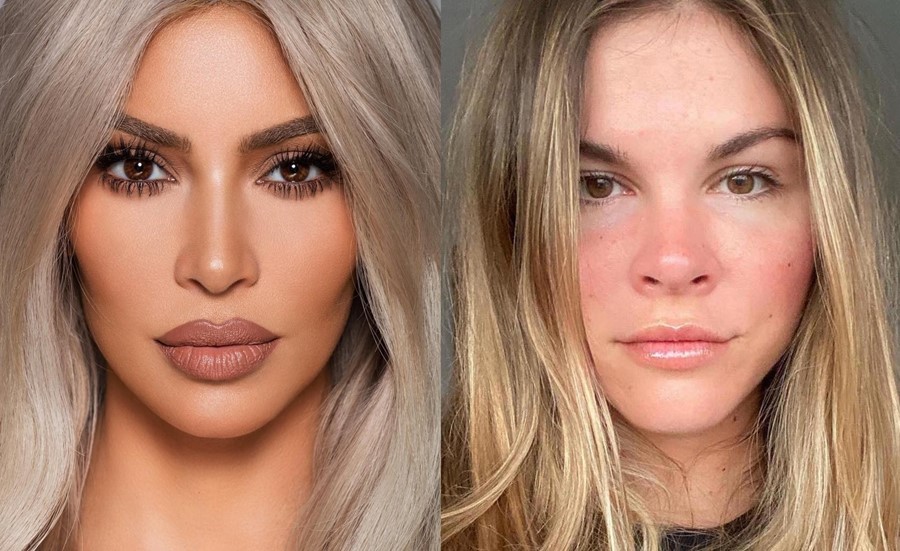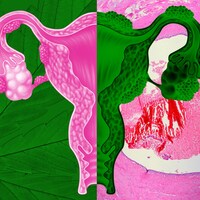Big changes at the two monoliths of 2010s beauty indicate that our priorities have shifted – and what is to come
In the 2010s, beauty culture was defined by two archetypal make-up looks. There was the my-face-but-dewier, no-make-up make-up look packaged in millennial pink by Emily Weiss’s Glossier. And then there was the ultra-glam, full-face, highlight-and-contour routine made mainstream by the inarguable icon of the decade, Kim Kardashian, which she then capitalised on with her eponymous make-up line KKW Beauty.
Both Glossier and KKW Beauty were paradigms of our newly digital culture. Launched in 2014, Glossier was the OG social-first beauty brand and immediately dominated the scene with its affordable, aesthetic products designed for #shelfies. In the early days of our online life, as our faces increasingly became the focus, Glossier made make-up accessible and taught us how to aesthetically curate our lives for the gram – right down to the bathroom shelf. Just five years later, it had reached unicorn status as a billion-dollar beauty brand.
Meanwhile, at the other end of the spectrum, our beauty beats were becoming heavier than ever after Kardashian introduced the public to contouring in 2012. As the online world became saturated with faces, we needed a way to stand out in small squares, for our features to pop in pixels. Previously the secret of drag queens and pro make-up artists, a selfie showing Kardashian’s unblended contour went viral and the practice quickly became a regular step in many of our routines. In 2017, her beauty line launched with just one product: contour kits, designed to recreate her sculpted appearance. The KKW range soon expanded and by June 2020, Coty had acquired a 20 per cent stake in KKW Beauty for $200 million, valuing the business at a billion dollars.
But the 2010s are over and change is afoot in the beauty sphere. A vibe shift is coming. At the end of May, Weiss announced that she was stepping down as Glossier CEO, moving instead to the new role of executive chairwoman. A mere seven days later, Kardashian relaunched KKW Beauty as the renamed, rebranded and reimagined SKKN. What can it mean that the two beauty monoliths of the past decade are evolving, almost in perfect synchronicity?
The rebranding of KKW Beauty officially signals what we’ve known for a while: the era of highlight and contour is over. Just as we’ve come to expect from the Kardashians, however, a new season is always coming. The family is used to shapeshifting to reflect the trending ideals. Kim’s continual transformation and manipulation of her physical self has been key to her success, and the fall of KKW Beauty and the rise of SKKN is no different.
Unlike KKW, SKKN comprises no make-up and instead is focused on nine prestige (prices range from $43 to $95) skincare products. This shift is no surprise. During the pandemic, skincare reigned supreme as we focused on routines and rituals over excessive make-up application. Once lockdown lifted, the make-up of our pre-pandemic life felt too heavy, moving the focus to a ‘five-minute face’ or the ‘clean girl aesthetic’.
Ulta Beauty has highlighted this “faux-effortlessness” as a defining trend of 2022. “Faux” being the key word here, as what the viral content fails to mention is that it’s an aesthetic only made possible by good genetics and expensive beauty work: braces, balayage, fake tan, lash extensions, brow waxing, filler, and the luxury of a dermatologist (a service not often offered on the NHS). The people who go viral typically have straight hair, clear skin, full brows, and are often young, wealthy, white (or light-skinned), thin, and conventionally attractive.
Ever keeping up with the trends, Kardashian’s SKKN products are “clean” and focused on “skinimalism”. She may have reduced her BBL and adopted a less overt beauty look but do not let that fool you into thinking her participation in beauty labour has diminished. To the New York Times, Kardashian described all nine of the SKKN products as “necessary”. “I wanted to just stay true to exactly what I use, even if everyone was saying this is overwhelming,” she said.
Once the defining beauty brand of an era, Glossier is instead facing a crossroads and needs to adapt in order to survive.
The nine-step lineup is said to mirror Kardashian’s own elaborate daily ‘ritual’. Of course, it doesn’t – no cream can replicate the years of laser, stem cell facials and PRP that she also mentions in the interview. What SKKN actually represents is a further extension of the newly energised beauty industrial complex, one designed to sell the faces of our idols to the masses, and which is increasingly becoming inaccessible to most.
While Kardashian is capitalising on the clean girl, five-minute face aesthetic, it is Glossier that the origins of the look can be traced back to. So why is it not the biggest brand in the industry right now?
An influencer in her own right, Weiss launched Glossier from her hugely successful blog Into The Gloss and has been a key face of the brand (and the wider #GirlBoss movement) ever since. For many, there is no Glossier without Weiss at the helm, so the news of her stepping down signals a shift regardless of the reasoning behind it. Weiss claims the move will suit her strengths, allowing her to continue steering the company’s future growth. However, the announcement comes after a string of controversies and setbacks for the brand.
In August 2020, Glossier closed several of its stores before quietly discontinuing its Glossier Play line. Online, an anti-Glossier movement had begun, criticising the brand’s non-inclusive shade range and toxic workplace culture. In 2021, Glossier’s US sales decreased by 26 per cent, and at the end of the year, just six months after raising $80m in funding, Glossier announced they were laying off a third of their staff. ‘Is Glossier in its Flop Era?’ a Reddit thread asked earlier this year.
Many have suggested that the millennial consumer Glossier had become synonymous with had aged out of the brand, opting for a more elevated beauty experience from labels such as Nars and Charlotte Tilbury. Meanwhile, the dewy, minimal make-up look fell somewhat out of favour with younger beauty consumers following the arrival of Euphoria in 2019 and its maximalist, expressive and bejewelled aesthetic. Ironically, just six months before the HBO drama hit our screens Glossier had launched its Play range, a more creative and colourful line that aimed to capture Gen Z. It could be argued the range came just half a year too early.
Glossier’s two most recent launches signal an attempt to appeal to Gen Z once again. The brand has announced Olivia Rodrigo as their first-ever celebrity partner, while their latest product launch is a range of bold-coloured eyeliners (very Euphoria-esque). Significantly, the eyeliners are based on the Glossier Play Color Slide and also launch the brand’s new approach to shopping through its partnership with YouTube Short’s new shoppable feature.
The past few years have seen a slot-machine cycle of beauty trends – from indie sleaze to clean girl, painfully precise Euphoria glam to anti-trend anarchy. As we re-align with self-expression post-pandemic and reconcile what make-up means in our new normal, the future currently feels like a liminal space, with no one brand, or aesthetic, taking the lead. Can Glossier carve out a space to cement themselves in our beauty futures? Only time will tell.
With Kardashian’s launch of SKKN, however, one trend set to define the next decade is clear. With botox and filler procedures rising rapidly in both the UK and the USA, and with many consumers trying to keep their beauty work a secret, the next era of beauty culture looks to be a far more covert, insidious and expensive operation that once again, benefits those in a position of privilege. The beauty culture of the next decade will be defined by this invisible labour. A focus on anti-ageing, tweakments and surreptitious procedures designed to defy detection.




